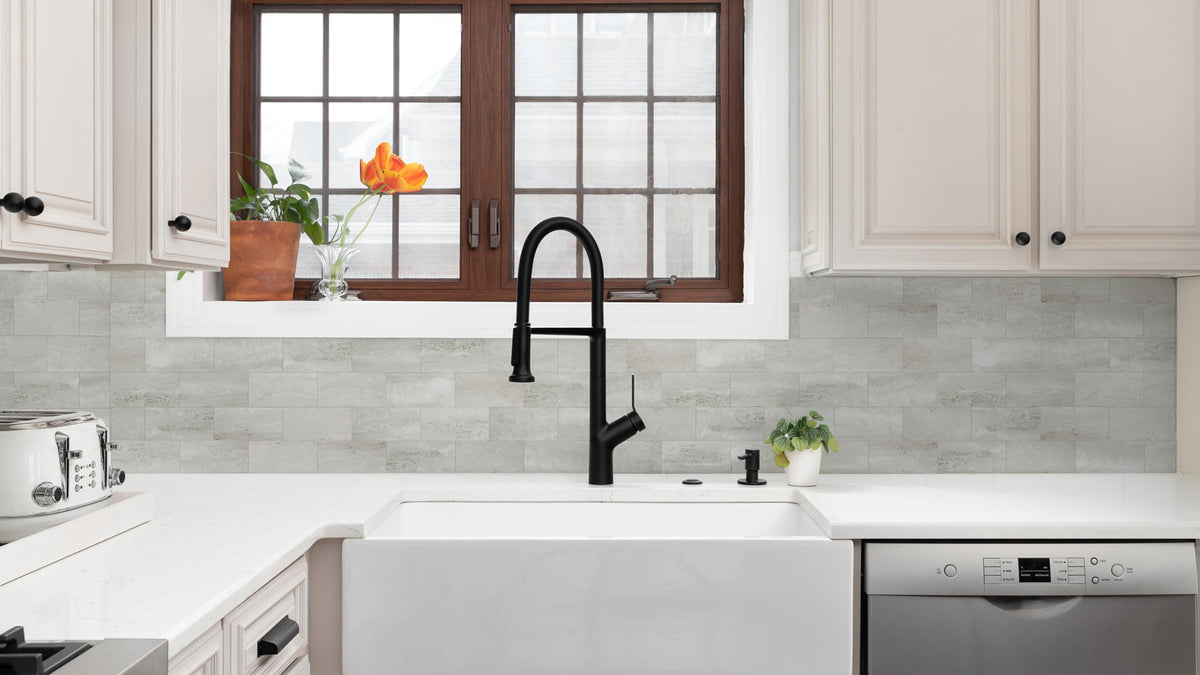
Vinyl vs. PVC Self-Adhesive Tiles Pros & Cons: Kitchen Heat Resistance
|
|
Lesezeit 5 min
|
|
Lesezeit 5 min
With modernization in architecture kitchen walls also require more reliable wall covering. Because a spill is not only the thing walls have to deal with, they face oil splashes, steam and constant heat. Nowadays, the most commonly used options are vinyl self adhesive tiles and PVC self adhesive tiles. Although both are known for their DIY installation, waterproof qualities, and decorative appeal. However, when it comes to heat resistance, not all of the peel andstick tiles perform equally.
That's where the debate of vinyl vs PVC tiles becomes important. In this article, we will explore which one is best for you and in what conditions. Let’s have a look at vinyl vs PVC tiles comparative analysis.
The sturdy vinyl and PVC self adhesive tiles are made based on a specific technology that directly influences the thermal resistance, durability, and performance in a kitchen.
Self adhesive vinyl tiles consist of PVC plastic with a protective wear finish. A printed pattern creates the illusion of substances such as wood or stone. An embossed effect provides a sense of realism. The back has a pressure-sensitive adhesive so it can be easily installed with peel and stick.
PVC tiles however are made of a PVC sheet, adding stone as well as carbon powder and other additives. A printed PVC film is laminated on top, whose patterns can be wood stains, stone, or decorations. Thereafter, the completed piece is rolled with an embossed metal wheel to give realistic grain and texture.
To conclude, Vinyl is superior in high-end aesthetics and resistance to heat, whereas PVC aims to be the most compatible with a wide range of applications and costs little.
One of the most important things to consider when selecting vinyl self-adhesive tiles over PVC self adhesive tiles is heat resistance. Wall materials are subjected to the incessant rises and falls of temperature in the kitchen to oil spatters and steam jets.
Although both materials may be subjected to the daily use of cooking appliances, the way in which they hold long-term exposure to high temperatures in certain areas, i.e., stovetop areas or zones of close range to the oven, varies considerably. The reactions of each material to be heated are provided in detail below, along with their strong and weak aspects, and some recommendations to follow in practical applications in a real kitchen.
Vinyl self adhesive tiles contain epoxy resin, which has greater heat resistance, but it depends on such factors as the exposure time and conditions.
PVC tiles are more sensitive to natural heat, but better versions made of SPC can bring some stability; they will not stand high-heat areas.
Real kitchen conditions make bursts of steam and sustained stove heating, and this is why the variety of tile is selected by the area of installation.
Short term heat (splashes, steam): Both vinyl and PVC cope well.
Long term heat (ex., stovetops, ovens): Tiles using vinyl epoxy or certified heat resistant PVC should be appropriate - temperature ratings of products must be consulted.
For instance, some PVC backsplash panels claim resistance up to around 392 °F (~200 °C), far above typical PVC thresholds—such products are treated or composite-enhanced.
Feature |
Vinyl Tiles |
PVC Tiles |
Installation |
Requires precise placement; repositionable |
Stick-on only—no repositioning |
Durability |
Scratch-resistant; may yellow or peel |
Flexible, impact-resistant; avoid direct flame |
Waterproof |
Fully waterproof |
Waterproof, but seams need sealing |
Maintenance |
Chemical-safe, non-porous |
Needs non-abrasive cleaners |
Aesthetic Options |
3D gloss effects; fewer designs |
Vast patterns, realistic textures |
Cost |
Higher price point |
Mid-range; budget-friendly |
Environmental Health |
Low-VOC epoxy options exist |
Some contain plasticizers; opt for low-VOC |
Designing a durable kitchen backsplash or wall covering requires matching the right tile to the heat level of each zone. Both vinyl and PVC self adhesive tiles can perform well, but their placement matters.
For areas exposed to direct heat—such as stovetops or oven sides—vinyl epoxy resin tiles or specially formulated heat-resistant PVC (rated ≥120 °C) are strongly recommended. These options provide greater stability and reduce risks of peeling, discoloration, or warping.
Spaces like countertops, refrigerator sides, or dining nooks don't face constant high heat. In these areas, PVC self-adhesive tiles offer excellent value due to their affordability, wide design range, and adequate performance.
To conclude, vinyl self adhesive tiles are more resistant to the heat and can have a luxurious 3D look, making them the ideal choice in kitchen zones with high budget allocation. PVC self adhesive tiles, on the other hand, offer economic and expanded designing options and they are therefore a good option in less warm up spaces, or on a low budget. Choose food safe products and prioritize temperature ratings such as UL or stated heat ratings. Properly prep and install your kitchen walls with those products to ensure a good and lasting looking wall.
Yes, Vinyl tiles use PVC (polyvinyl chloride). In the case of self-adhesive types, the terms may be used interchangeably by producers and sellers.
They are resistant to normal kitchen heat but not to stove or oven placement. Adhesive can break down, as tiles are prone to peeling, bubbling, or warping close to large heat sources.
The quality and environment determine the lifespan. They have a long life in low-heat, low-traffic areas, up to years, whereas in kitchens, life is a short 3 and 10 years before peeling or fading.



